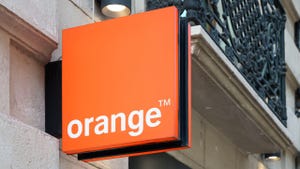Deutsche Telekom is expected to provide an update on its pan-net strategy at MWC. It needs to be good.

It was a bit of theater in keeping with the razzmatazz of last year's Mobile World Congress. Standing side-by-side at the Deutsche Telekom stand, CEO Timotheus Höttges and European head Claudia Nemat pulled a makeshift lever to symbolize the firing up of the German incumbent's pan-European network.
Figure 1: Flicking the Switch  Deutsche Telekom CEO Timotheus Höttges and Member of the Deutsche Telekom Board of Management, Europe and Technology, Claudia Nemat, get a handle on IP services.
Deutsche Telekom CEO Timotheus Höttges and Member of the Deutsche Telekom Board of Management, Europe and Technology, Claudia Nemat, get a handle on IP services.
But since the pan-net show began, there has been a notable lack of dazzle. Trials of pan-net IPTV and IP-VPN services have been under way in Croatia, Hungary and Slovakia for nearly one year. Yet in that time, Deutsche Telekom AG (NYSE: DT) has had almost nothing to say about customer feedback, the extension of trial services to other countries or the prospect of a commercial service. Greater agility might be the ultimate goal, but Deutsche Telekom seems to be limping towards it. (See DT Completes All-IP Move in Croatia.)
The German operator is expected to provide an update on its pan-net rollout during next week's Mobile World Congress. That is likely to include the extension of its pilot to a "broader footprint," judging by comments from vice president Axel Clauberg in October. The question is whether this will do enough to address concern it is moving too slowly. By 2020, it wants to slash €1.2 billion ($1.3 billion) off operating costs as a result of the pan-net program. Moreover, if it cannot accelerate its service development cycle over this timeframe, it risks losing out to fast-moving web-scale players that have been steadily encroaching on its turf. (See DT, Vodafone to Launch SDN-Based VPNs.)
All that said, Deutsche Telekom arguably has a more coherent and compelling network strategy than any of its traditional rivals. Taking advantage of its aggressive rollout of all-IP -- what Höttges likes to call the "lingua franca" of the digital age -- the operator is transforming a motley assortment of central and eastern European networks into a seamless, next-generation system.
In the future, this means the service a customer gets in Romania will be based on exactly the same platform used in Germany. Instead of maintaining 50 service platforms for each of its 13 countries, or 650 in total, Deutsche Telekom will have just 50 across the region altogether.
Besides allowing it to launch services in multiple markets in a fraction of the time it would previously have taken, this overhaul should lead to massive cost savings as Deutsche Telekom decommissions equipment and reduces staff numbers. Of the €1.2 billion ($1.3 billion) in cost savings it wants to realize by 2020, €500 million ($556 million) is expected to come from outside Germany, Nemat has revealed. That will include €200 million ($222 million) from harmonization of platforms and lower spending on vendors, €200 million ($222 million) from simplification of technical services and about €50 million ($56 million) from PSTN shutdown.
Indeed, all-IP moves of this nature could even provide a financial justification for takeover activity. The thinking is that a service provider could fatten margins after acquisitions by closing facilities and releasing employees it would have needed in a PSTN environment. (See All-IP DT Could Drive Euro M&A, Say Analysts.)
For more NFV-related coverage and insights, check out our dedicated NFV content channel here on Light Reading.
Yet Deutsche Telekom's target of completing its all-IP migration by 2018 is extremely ambitious. France's Orange (NYSE: FTE) does not expect to be an all-IP operator until 2020, while the UK's BT Group plc (NYSE: BT; London: BTA) thinks it will be 2025 before there are no traces of PSTN technology left in its networks. Earlier this week, Orange CEO Stéphane Richard said there would have to be more progress on all-IP rollout, as well as a more favorable regulatory framework, before takeover activity involving the "big European players" could occur. (See Orange CEO Sees 50:50 Chance of Bouygues Deal.)
Operator | All-IP deadlines | Progress to date | Publicly stated goals/benefits | Notes |
BT | 2025 | All-IP core network already built | Simplifying estate; replacing legacy networks; saving costs | Operator claims 21CN project achieved all-IP-to-exchanges target and that current initiative will take all-IP to premises |
Deutsche Telekom | 2018 | Croatia, Macedonia, Montenegro and Slovakia are all-IP | Service agility; cost savings ( euro 1.2 billion ($1.3 billion) by 2020 from use of cloud-based technology) | All-IP move is designed to support a major reduction in the number of service platforms Deutsche Telekom maintains across Europe, from about 650 before the process began to just 50 at its conclusion |
KPN | N/A | >60% of connections | Optimization for very high data volumes; reduced complexity; faster time to market | "To support our best-in-class access services, we continue to move towards an all-IP network," said KPN in 2014 annual report. "Moving towards a single IP core is needed to ensure best-in-class integrated services" |
Orange | 2020 | All broadband services in Mauritius are all-IP | Improved user experience; better scalability, security and energy efficiency; enabling development of new services | All-IP pilot under way in Mauritius, which was chosen, says Orange, because of its "size, the representativeness of the different markets, such as residential, enterprise and mobile, and the presence of all services and technologies" |
Swisscom | 2017 | >25% of connections; >33% of customers | Enabling cost-effective use of new services; offering services irrespective of type of access technology | Has migrated data transport network to IP, commissioned IP-based telephony and multimedia platform and been offering IP-based services since 2009 |
Telecom Italia | N/A | N/A | N/A | Migration from PSTN to all-IP under way |
Telefonica | N/A | N/A | N/A | All-IP forms a part of network transformation Telefonica is carrying out |
Telekom Austria | N/A | All fixed voice customers in Austria on all-IP | To overcome the problem of technology obsolescence related to the use of legacy networks | Has revealed that another subsidiary will shortly make an announcement on all-IP conversion |
Source: Goldman Sachs, operators, Light Reading. |
At last year's Mobile World Congress, Deutsche Telekom had completed the all-IP transition in just two countries, those being the relatively small markets of Macedonia and Slovakia. Since then it has added Croatia and Montenegro to the list, and it seems likely to reach the all-IP milestone this year in Hungary, where 73% of fixed lines were IP-based in September. (See DT Completes All-IP Move in Croatia.)
Elsewhere, however, it is a different matter. Just 17% of fixed lines in Romania and 1% in Greece were IP-based in September. Across all of its European markets outside Germany, 55% of fixed lines were still using elements of PSTN technology by the same date. And in Germany, which accounts for about 70% of the operator's total number of fixed lines in the region, just 31% of lines were all-IP ones in late 2015.
Country/region | Total fixed lines in September ('000) | IP fixed lines in September ('000) | Percentage all-IP (September) | Status/target for completion |
Macedonia | N/A | N/A | 100% | Completed |
Slovakia | 858 | 858 | 100% | Completed |
Croatia | 1,020 | 1,001 | 100% | Completed |
Montenegro | N/A | N/A | N/A | 2015 |
Hungary | 1,614 | 1,178 | 73% | 2016 |
Romania | 2,117 | 362 | 17% | 2018 |
Greece | 2,577 | 36 | 1% | 2018 |
Europe | 8,735 | 3,944 | 45% | 2018 |
Germany | 20,354 | 6,354 | 31% | 2018 |
Note: Europe covers all of Deutsche Telekom's European subsidiaries bar Germany. Outside its domestic market, the operator has a fixed and/or mobile presence in Albania, Austria, Croatia, the Czech Republic, Germany, Greece, Macedonia, Montenegro, the Netherlands, Poland, Romania, Slovakia and the UK, through its EE joint venture with Orange. Source: Deutsche Telekom. |
What's more, while the clock is ticking, the capital costs are growing. Deutsche Telekom has previously indicated it will save around €10 ($11.1) per customer per year as a result of all-IP migration. But it has also put the upfront investment at between €30 ($33.4) and €60 ($66.7) per customer. That works out at a total cost of between €873 million ($970 million) and €1.75 billion ($1.95 billion), including money already spent, based on Deutsche Telekom's fixed-line figures in September. About 65% of that investment still needs to be made.
All-IP, of course, is not the end game for Deutsche Telekom. Through its Terastream initiative, it is exploring so-called New IP technologies like SDN and NFV as part of the pan-net program. According to a white paper published last year by management consultancy Arthur D. Little and equipment vendor Alcatel-Lucent (NYSE: ALU), the use of these technologies by European operators could lead to operational cost savings of about €14 billion ($15.6 billion) annually, or roughly 10% of total industry operating expenditure. And operators could save another €25 billion ($27.8 billion) in non-network costs from changes to their operating model related to the use of SDN and NFV. (See Will Investing in SDN & NFV Be Worth It?)
But if Deutsche Telekom is to take full advantage of these technologies, it first needs to have IP as a common platform throughout its European networks, Clauberg has previously told Light Reading. In other words, it must become as fluent as possible in the lingua franca of the digital age. And the sooner it can demonstrate its proficiency, the better. (See DT's Journey to a New IP World.)
— Iain Morris, 

 , News Editor, Light Reading
, News Editor, Light Reading
Read more about:
EuropeAbout the Author(s)
You May Also Like











